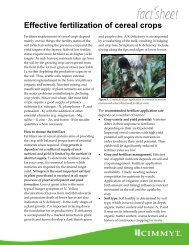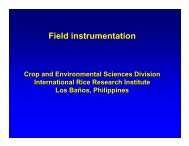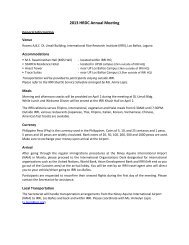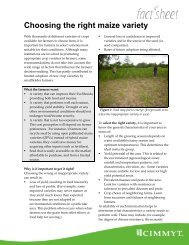Bacterial blight - Rice Knowledge Bank - International Rice ...
Bacterial blight - Rice Knowledge Bank - International Rice ...
Bacterial blight - Rice Knowledge Bank - International Rice ...
Create successful ePaper yourself
Turn your PDF publications into a flip-book with our unique Google optimized e-Paper software.
<strong>Bacterial</strong> BlightNature and disease symptoms<strong>Bacterial</strong> Blight – Page 1 of 2<strong>Bacterial</strong> leaf <strong>blight</strong> is caused by Xanthomonas oryzae pv. oryzae. On nutrient agar, bacterial coloniesare circular, light yellow, and convex, and produce a yellow pigment (Webster and Gunnell 1992; Fig. 1).rice fact sheetsFig. 1. Colonies of Xanthomonasoryzae pv. oryzae.The disease is observed on both seedlings and older plants. Onseedlings, infected leaves turn grayish green and roll up. Asdisease progresses, leaves turn yellow to straw-colored and wilt,leading whole seedlings to dry up and die. This expression of thedisease is known as “kresek” (Ou 1985, Mew et al 1993). This formof the disease on seedlings may sometimes be confused with earlyrice stem borer damage.On older plants, lesions usuallydevelop as water-soaked toyellow-orange stripes on leafblades or leaf tips or onmechanically injured parts ofleaves (Fig. 2). Lesions have a wavy margin and progress toward theleaf base. On young lesions, bacterial ooze resembling a milky dewdrop can be observed early in the morning. The bacterial ooze later ondries up and becomes small yellowish beads underneath the leaf. Oldlesions turn yellow to grayish white with black dots due to the growthof various saprophytic fungi. On severely infected leaves, lesions mayextend to the leaf sheath.To quickly diagnose bacterial leaf <strong>blight</strong>, a young lesion is cut acrossand placed in a transparent glass container with clear water. After afew minutes, the container (held against light) will show a turbid liquidexuding from the cut end of the leaf. The turbid exudates consist ofbacteria emitted from the cut end of the infected leaf.Occurrence of bacterial leaf <strong>blight</strong>The disease occurs in both tropical and temperate environments, particularly in irrigated and rainfedlowland areas. It is commonly observed when strong winds and continuous heavy rains occur (Ou 1985,Mew et al 1993). The disease is severe in susceptible rice varieties under high nitrogen fertilization(Reddy et al 1979).Importance of the diseaseFig. 2. Typical symptoms ofbacterial <strong>blight</strong> on leaves.<strong>Bacterial</strong> <strong>blight</strong> is among the major diseases of rice, and has historically been associated with majorepidemics (Ou 1985, Mew et al 1993). The advent of rice varieties bearing genes with resistance to thedisease has changed the perception of the disease: the incorporation of host-plant resistance genes inrice varieties, their adoption, and their deployment in the world’s main rice-producing environments isprobably one of the most significant evidences of the role of plant pathology in agricultural development.<strong>Bacterial</strong> <strong>blight</strong> nevertheless remains an important concern nowadays because many countries do notendorse the release of new rice varieties unless they carry resistance to the disease.Whenever susceptible rice varieties are grown in environments that favor bacterial <strong>blight</strong>, very high yieldlosses (over 70%; Mew et al 1993, Mew and Vera Cruz 2001) may be caused by bacterial <strong>blight</strong>.Nowadays, however, yield losses of 1% or less are the norm, as resistant varieties have been deployedin the main rice-producing zones of Asia (Savary et al 2000). Breeding for resistant varieties that carryresistance genes therefore remains a continuing challenge (Bonman et al 1992).For more information, visit the <strong>Rice</strong> <strong>Knowledge</strong> <strong>Bank</strong>: http://www.knowledgebank.irri.orgDeveloped with input from: I. Ona, N. Castilla, S. Savary, C.M. Vera CruzProduced by the <strong>International</strong> <strong>Rice</strong> Research Institute (IRRI) • © 2010, IRRI, All rights reserved • Mar 2010
<strong>Bacterial</strong> Blight – Page 2 of 2Control of <strong>Bacterial</strong> Leaf Blightrice fact sheetsBy and large, host-plant resistance has proven to be the most efficient, most reliable, and cheapest toolto control bacterial <strong>blight</strong>. Varieties resistant to bacterial <strong>blight</strong> may be considered as one of the bestexamples of the translation of phytopathological science into successful pro-poor and sustainabledisease management (Bonman et al 1992). Twenty-eight genes conferring resistance to bacterial <strong>blight</strong>have been reported in rice (Jena and Mackill 2008). Most of these are dominant genes, and some ofthem have been cloned. Marker-assisted selection for resistance to bacterial <strong>blight</strong> is becoming thenorm in breeding programs, and this renders the accumulation of different resistance genes in the samevariety easier. <strong>Bacterial</strong> <strong>blight</strong> disease control options therefore include• The use of resistant varieties. Sources of single resistance genes and multiple resistancegenes are now available for breeding purposes.• The use of balanced amounts of plant nutrients, especially nitrogen.• Ensuring good drainage of fields (in conventionally flooded crops) and nurseries.• Keep fields clean - removing weed hosts and plowing under rice stubble, straw, rice ratoonsand volunteer seedlings, which may constitute sources of inoculum.• Allowing fallow fields to dry to suppress inoculum in the soil and plant residues.ReferencesBonman JM, Khush GS, Nelson RJ. 1992. Breeding for resistance to rice pests. Annu. Rev. Phytopathol. 30:507-528.Jena KK, Mackill DJ. 2008. Molecular markers and their use in marker-assisted selection in rice. Crop Sci. 48:1266-1276.Mew TW, Vera Cruz CM. 2001. <strong>Bacterial</strong> <strong>blight</strong> of rice. In: Maloy OC, Murray TD, editors. Encyclopaedia of plantpathology. John Wiley and Sons, New York. p 71-74.Mew TW, Alvarez AM, Leach JE, Swings J. 1993. Focus on bacterial <strong>blight</strong> of rice. Plant Dis. 77:5-12.Ou SH. 1985. <strong>Rice</strong> diseases. Second edition. Commonwealth Mycological Institute, Kew, Surrey. 380 p.Reddy APK, Katyal JC, Rouse DI, MacKenzie DR. 1979. Relationship between nitrogen fertilization, bacterial leaf<strong>blight</strong> severity, and yield of rice. Phytopathology 69:970-973.Savary S, Willocquet L, Elazegui FA, Teng PS, Du PV, Zhu D, Tang Q, Lin X, Singh HM, Srivastava RK. 2000. <strong>Rice</strong>pest constraints in tropical Asia: characterization of injury profiles in relation to productionsituations. Plant Dis. 84:341-356.Webster RK, Gunnell PS. 1992. Compendium of rice diseases. American Phytopathology Society, St. Paul,Minnesota. 62 p.For more information, visit the <strong>Rice</strong> <strong>Knowledge</strong> <strong>Bank</strong>: http://www.knowledgebank.irri.orgDeveloped with input from: I. Ona, N. Castilla, S. Savary, C.M. Vera CruzProduced by the <strong>International</strong> <strong>Rice</strong> Research Institute (IRRI) • © 2010, IRRI, All rights reserved • Mar 20102


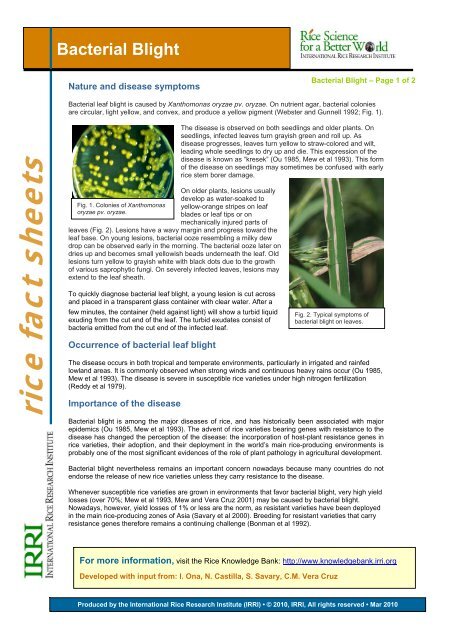


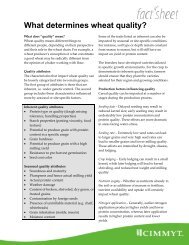



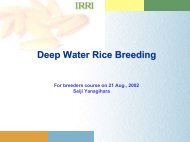
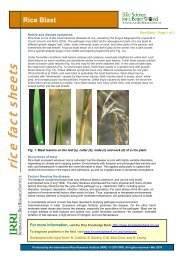
![International Standards' Organization â Rice Specification [ISO 7301]](https://img.yumpu.com/36696862/1/190x245/international-standards-organization-a-rice-specification-iso-7301.jpg?quality=85)

